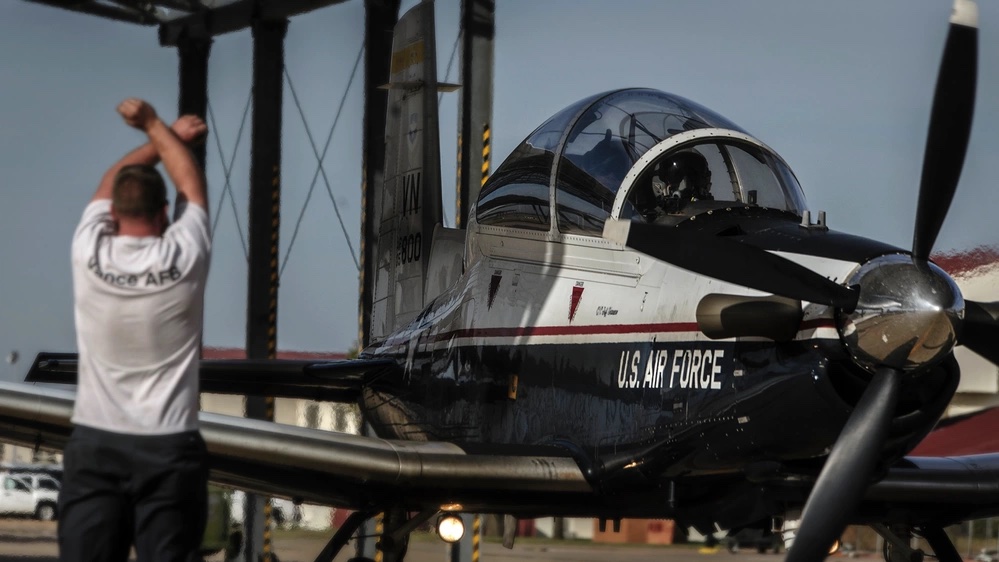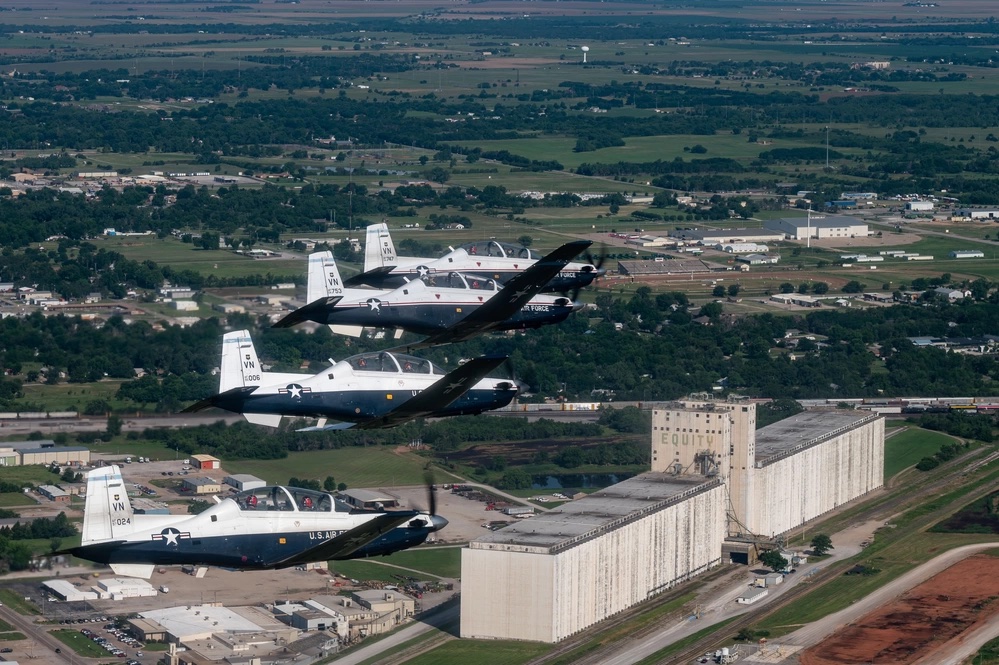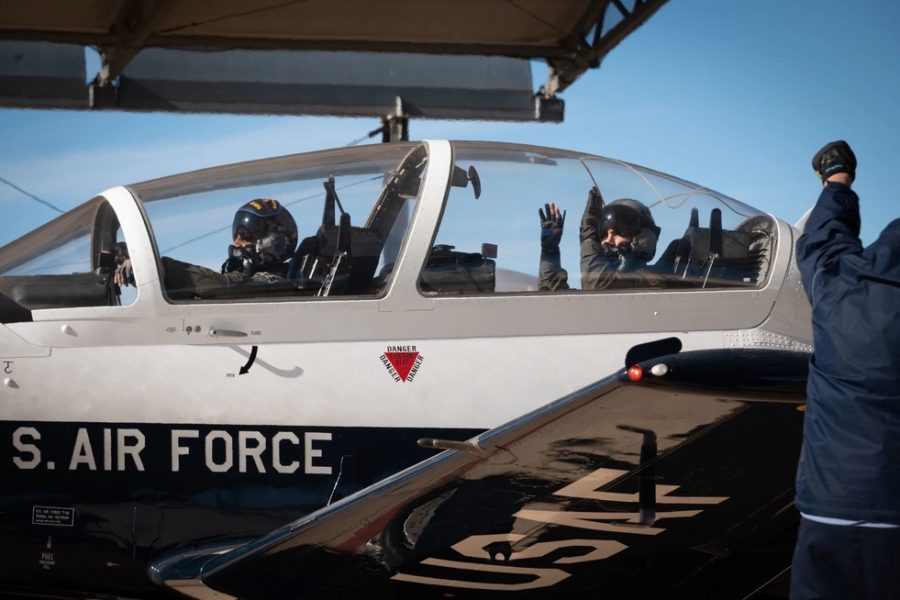Two months after a surprise thunderstorm grounded nearly all of its T-6 Texan II training aircraft, Vance Air Force Base, Okla., is ahead of schedule training undergraduate pilots, an achievement that required aircraft maintainers to work around the clock and instructor pilots (IPs) to come in on weekends.
“We thought it was going to take three months to recover, to get to where we were prior to the weather event,” Lt. Col. Michael Kissinger, commander of the 33rd Flying Training Squadron, told Air & Space Forces Magazine.
“In reality, everyone came together, our maintainers and our IPs, and we got back to on-timeline within one month of the event,” he added. “We are presently about two to three days ahead of timeline two months removed from the event.”
The 33rd is one of two student pilot training squadrons at Vance that together operate 99 T-6s, the turboprop aircraft which Air Force student pilots learn to fly before moving on to specialized training for fighter/bomber, cargo/tanker, heavy propeller, or rotary wing aircraft.
A major thunderstorm was not forecasted over Vance for the night of July 21, but the base wound up being the spot where the storm cell collapsed, Kissinger said.

When not in use, T-6s are usually parked outside and tied down. During the storm, they were subjected to 90 mph winds, which blew protective straps off propellers and sent them spinning. That can be hazardous to the aircraft, because without oil pumping through the turned-off engines, the propellers can grind chips off components and send them into the rest of the system.
The wind can also damage control surfaces like ailerons and elevators. In some cases, aircraft collided with each other or with structures after the wind tore off their straps.
All those risks meant even the visibly undamaged planes had to be grounded for inspections. In all, 78 of the 99 T-6s were grounded, leaving the 71st Flying Training Wing with just 21 percent of its usual T-6 fleet and no let-up in pilot training requirements. The two T-6 squadrons usually have a combined 150 students in the flight stage of their training, broken down into smaller classes staggered at different stages of the process. The syllabus calls for each student to fly about 100 hours.
“No one immediately said ‘Oh, we’re not going to graduate anyone on time,’” Kissinger said. “The general feeling was ‘well, this is a problem, and we’re going to work through it.’”
The stakes were especially high because a slowdown in undergraduate pilot training has ripple effects in specialized pilot training and operational units.
“Any time we don’t graduate on time, the Air Force feels those effects,” Kissinger explained.
The contract maintenance teams worked “24/7 in the literal sense of that term” to inspect aircraft and return them to flight as soon as possible, Kissinger said. On the flying side, planners dropped all sorties that were not essential to student production, such as airshows and upgrade training for IPs. Since not as many IPs were flying sorties due to the reduced number of aircraft, they helped run extra simulator sessions alongside the civilian instructors who usually lead the simulators. The goal was to maximize student sorties on the few available aircraft while still giving students the training they needed to graduate.
“We were trying to schedule around 130, 140 sorties a day,” before the storm, Kissinger said. “If you lose a single day, it might take several weekends to make up for it.”
Indeed, the squadron had gone from two days ahead of schedule to four days behind the timeline, a rare event at Vance. But the team rose to the challenge, with IPs working weekends in addition to their 10- to 12-hour workdays.
“You always expect military people to do their duty, but at the same time when you see people just knock it out of the park and do so while maintaining a healthy morale in the squadron, I absolutely couldn’t be prouder of the 33rd, or really team Vance at large,” Kissinger said.
While the IPs worked weekends, they also needed some luck—there was no margin left for a run of poor weather or another storm.
“We needed everyone to be 100 percent efficient with the sorties and time that we had,” he said. “But there’s no buffer, and I think that’s the stress that gets put on the force, because they’re working hard and there are some things outside their control.”

Meanwhile, the maintainers brought back all but nine of the 78 aircraft damaged from the storm, with the final nine awaiting replacement parts, said Sherry Teague, the director of maintenance quality assurance at Vance.
“Our contract partners and support personnel put in the hours to get our damaged aircraft back to a safe flying condition,” she said. “They gathered a lot of the data that the engineers used to decide how to get our fleet back up and running as quickly as possible and keep our pilots safe.”
As more aircraft returned to flight, the fleet could sustain about 150 sorties a day, allowing for IP upgrades and airshows again.
The comeback is a bright spot in the wider Air Force pilot training enterprise, which in August had a 900-pilot backlog due in part to aging aircraft like the T-38 Talon, used to train future fighter and bomber pilots.
In fiscal 2022, the Air Force produced 1,276 pilots. In 2023, that number rose to around 1,350, still short of the goal of 1,470. Facing strong demand, the branch is aiming for 1,500 new pilots in fiscal 2024—and the thunderstorm at Vance seemingly won’t interfere with that goal after all.
“That collaboration: everyone having that shared vision of what it takes to get across the line, and then executing, that’s really the big takeaway,” Kissinger said.
